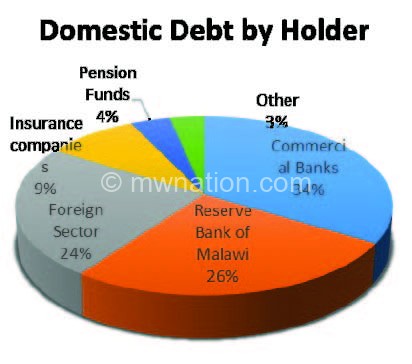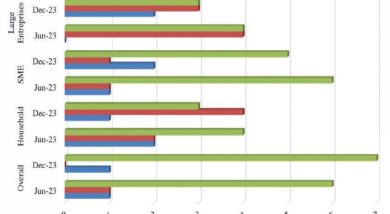Bankers wary of rising debt
Bankers Association of Malawi (BAM), a grouping of commercial banks, has expressed worry over rising domestic debt, saying it is affecting excess liquidity which could have been channelled towards private sector growth.
BAM president Kwenele Ngwenya said this in an interview on the back of rising public debt recorded at K4.1 trillion as at the end of June 2020, majority of which at 57.3 percent, or K2.3 trillion, is domestic debt.

He said: “Government instruments are home to pack excess liquidity. It is not an ideal situation. We don’t want significant loan portfolio sitting in government debt.
“We would prefer that sitting in the private sector creating jobs, growing the economy. But unfortunately, in an environment where the private sector is a growing one and is still finding its feet, with so much liquidity, you find yourself investing more in government instruments to pack your liquidity in the meantime.”
Treasury figures indicate that as at the end June 2020, Malawi’s total public debt was recorded at K4.1 trillion, with more than half of it being domestic debt.
However, with the government having stopped borrowing from the Reserve Bank of Malawi (RBM) since early 2018, domestic debt is shifting towards commercial banks and the non-bank institutions.
This means that additional financing needs are being met through borrowing from commercial banks and the non-bank sector.
World Bank figures show that the share of domestic debt held by RBM has been declining, from 57 percent at the end of December 2017 to 32 percent at the end of September 2019.
The share went down further to 26 percent at the end of June 2020.
Effectively, this translates to an increased share of domestic debt being held by commercial banks and the non-bank sector, with the proportion increasing from 19 percent and 24 percent at the end of December 2017, respectively, to 29 percent and 39 percent at the end of September 2019.
In the current financial year, for instance, Treasury intends to finance the fiscal deficit, which has been projected at K754.8 billion, with foreign borrowing amounting to K224.8 billion and K530.1 billion from domestic sources.
What is more worrying is the distribution of banking sector loans that are heavily skewed towards wholesale and retail, agriculture, forestry, fishing and hunting, which control about 42.3 percent of total loans while the manufacturing sector controls only around 13.9 percent of the total loans.
Figures from BAM show that total banking sector loans increased from K397.2 billion in 2015 to K637.3 billion at the end of June 2020.
Ngwenya, who is also NBS Bank plc chief executive officer: “The manufacturing industry don’t come with bankable projects, they come as an idea. If you push it forward, they don’t have an extended thought as to how they will compete in the global community.
“The world is flat now and movement of goods is becoming cheaper. We produce for export as raw material. Why not add value in supply chain?”
In its recently published Malawi Economic Monitor, the World Bank observed that the consistent financing of fiscal deficits by high-cost domestic borrowing has led to a recent surge in domestic debt and this is expected to rise further.
Reads the report in part: “This will increase vulnerability of public debt which is already at high risk of debt distress.
“Moreover, given the high and increasing cost of domestic debt, it will further narrow future fiscal space for discretionary policy.”
Earlier, Minister of Finance Felix Mlusu said one of the major fiscal challenges is the rising public debt stock.




